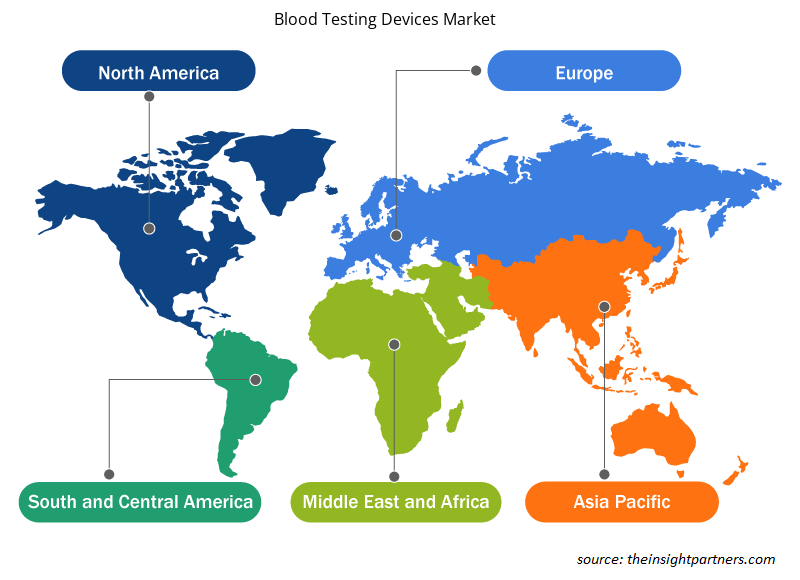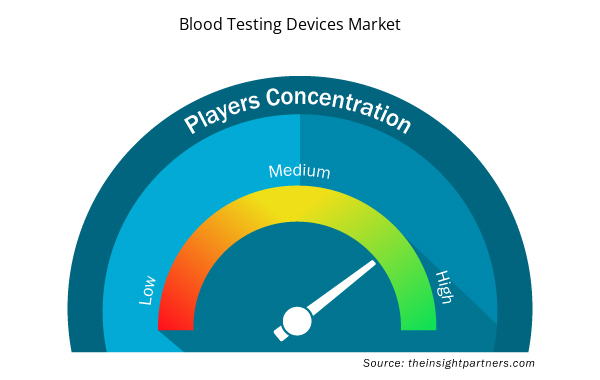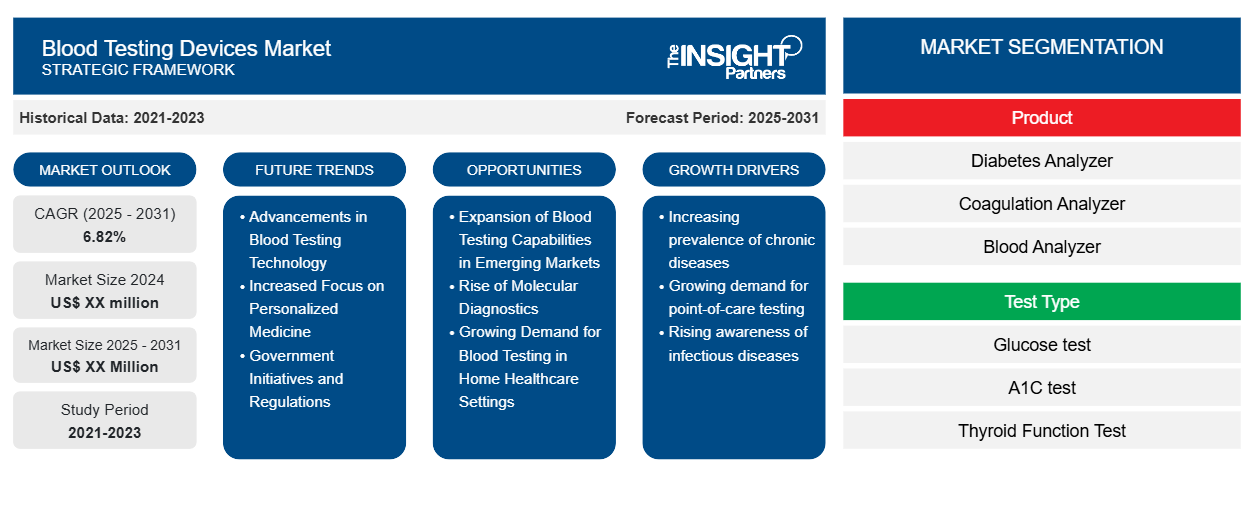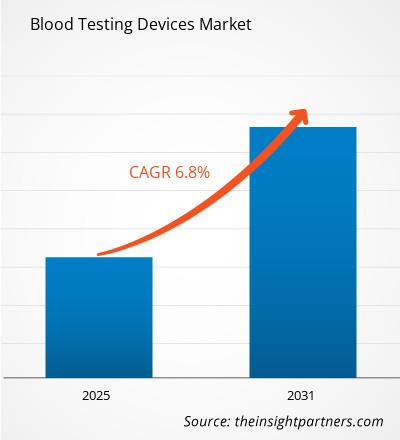Se espera que el mercado de dispositivos de análisis de sangre registre una CAGR del 6,82 % entre 2023 y 2031, con un tamaño de mercado que se expandirá de US$ XX millones en 2023 a US$ XX millones en 2031.
El informe está segmentado por producto (analizador de diabetes, analizador de coagulación, analizador de sangre y analizador de hematología), tipo de prueba (prueba de glucosa, prueba de A1C, prueba de función tiroidea, prueba de creatinina, prueba de coagulación, hemograma completo, prueba directa de LDL y otras) y usuario final (hospitales y clínicas, centros de diagnóstico y atención domiciliaria). El análisis global se desglosa aún más a nivel regional y por países principales. El informe ofrece el valor en USD para el análisis y los segmentos anteriores.
Propósito del Informe
El informe Blood Testing Devices Market de The Insight Partners tiene como objetivo describir el panorama actual y el crecimiento futuro, los principales factores impulsores, los desafíos y las oportunidades. Esto proporcionará información a diversas partes interesadas del negocio, como:
- Proveedores/fabricantes de tecnología: Para comprender la dinámica cambiante del mercado y conocer las oportunidades potenciales de crecimiento, lo que les permitirá tomar decisiones estratégicas informadas.
- Inversionistas: Realizar un análisis exhaustivo de tendencias sobre la tasa de crecimiento del mercado, las proyecciones financieras del mercado y las oportunidades que existen en toda la cadena de valor.
- Órganos reguladores: Regular las políticas y vigilar las actividades del mercado con el objetivo de minimizar los abusos, preservar la confianza de los inversores y defender la integridad y la estabilidad del mercado.
Segmentación del mercado de dispositivos para análisis de sangre
Producto
- Analizador de diabetes
- Analizador de coagulación
- Analizador de sangre
- Analizador de hematología
Tipo de prueba
- Prueba de glucosa
- Prueba de A1C
- Prueba de la función tiroidea
- Prueba de creatinina
- Prueba de coagulación
- Hemograma completo
- Prueba directa de LDL
- Otros
Usuario final
- Hospitales y clínicas
- Centros de diagnóstico
- Cuidado domiciliario
Geografía
- América del norte
- Europa
- Asia-Pacífico
- América del Sur y Central
- Oriente Medio y África
Geografía
- América del norte
- Europa
- Asia-Pacífico
- América del Sur y Central
- Oriente Medio y África
Personalice este informe según sus necesidades
Obtendrá personalización en cualquier informe, sin cargo, incluidas partes de este informe o análisis a nivel de país, paquete de datos de Excel, así como también grandes ofertas y descuentos para empresas emergentes y universidades.
- Obtenga las principales tendencias clave del mercado de este informe.Esta muestra GRATUITA incluirá análisis de datos, desde tendencias del mercado hasta estimaciones y pronósticos.
Factores impulsores del crecimiento del mercado de dispositivos para análisis de sangre
- Aumento de la prevalencia de enfermedades crónicas: En los últimos 25 años, la incidencia de enfermedades crónicas ha aumentado en todo el mundo debido a los cambios en el estilo de vida, que dan lugar a un aumento del número de cirugías. Por ejemplo, el cáncer colorrectal es uno de los cánceres más frecuentes y letales que se desarrollan en las personas debido a la influencia combinada de factores genéticos y ambientales. Según la Organización Mundial de la Salud (OMS), el cáncer colorrectal fue identificado como el tercer cáncer más común y el segundo cáncer con mayor causa de muerte, con aproximadamente 1.926.425 casos a nivel mundial en 2022. La prevalencia de enfermedades crónicas como la diabetes, el cáncer y las enfermedades cardiovasculares está aumentando a nivel mundial, lo que genera una creciente necesidad de pruebas de diagnóstico.
- Demanda creciente de pruebas en el punto de atención: los dispositivos para pruebas en el punto de atención (POCT) permiten a los médicos o proveedores de atención médica administrar pruebas en el hogar del paciente o en un consultorio médico que no sea un laboratorio, lo que limita las pruebas de laboratorio externas y mejora la prestación del servicio al paciente. La causa principal de esta tendencia también se debe al avance de tecnologías como la microfluídica, la nanotecnología y los sistemas de laboratorio en un chip. Estas tecnologías permiten utilizar aparatos de prueba más pequeños y avanzados que no solo son portátiles, sino que pueden ser utilizados por cualquier persona sin demasiado esfuerzo.
- Conciencia creciente sobre las enfermedades infecciosas: la creciente conciencia sobre las enfermedades infecciosas ha creado una mayor necesidad de dispositivos de análisis de sangre que puedan detectar y diagnosticar estas enfermedades de manera rápida y precisa. La dinámica de transmisión de enfermedades infecciosas como el VIH y la hepatitis ha aumentado la demanda de dispositivos de análisis de sangre que puedan proporcionar un diagnóstico rápido y preciso de estas enfermedades.
Tendencias futuras del mercado de dispositivos para análisis de sangre
- Avances en la tecnología de análisis de sangre: los avances en la tecnología de análisis de sangre, como la miniaturización, la automatización y la digitalización, están permitiendo obtener resultados más rápidos y precisos. Estos avances también están reduciendo el costo de los dispositivos de análisis de sangre, haciéndolos más accesibles para una gama más amplia de proveedores de atención médica y pacientes.
- Mayor atención a la medicina personalizada: la creciente atención a la medicina personalizada está impulsando la demanda de dispositivos para análisis de sangre que puedan proporcionar información detallada sobre el perfil genético y el estado de salud de una persona. Los dispositivos para análisis de sangre pueden ayudar a identificar marcadores genéticos asociados con ciertas enfermedades, lo que permite a los proveedores de atención médica desarrollar planes de tratamiento específicos.
- Iniciativas y reglamentaciones gubernamentales: Las iniciativas y reglamentaciones gubernamentales destinadas a mejorar los resultados de la atención médica y reducir los costos de la misma están impulsando la demanda de dispositivos para realizar pruebas de sangre. Por ejemplo, los Centros de Servicios de Medicare y Medicaid (CMS) han implementado nuevas políticas de reembolso para los dispositivos de prueba POC, haciéndolos más accesibles para los proveedores de atención médica.
Oportunidades de mercado para dispositivos de análisis de sangre
- Expansión de las capacidades de análisis de sangre en los mercados emergentes: a medida que se desarrolla la infraestructura de atención médica en los mercados emergentes, existe una creciente demanda de dispositivos de análisis de sangre que puedan diagnosticar y monitorear una variedad de enfermedades, incluidas las enfermedades infecciosas y el cáncer.
- El auge del diagnóstico molecular: el desarrollo de tecnologías de diagnóstico molecular, como la reacción en cadena de la polimerasa (PCR) y las pruebas basadas en PCR, podrían permitir una detección más precisa y sensible de enfermedades genéticas y agentes infecciosos. Además, se espera que el aumento de las inversiones de los gobiernos y los actores públicos en el diagnóstico molecular impulse las oportunidades de colaboración y alianzas.
- Creciente demanda de análisis de sangre en entornos de atención médica domiciliaria: la creciente tendencia hacia la atención médica domiciliaria y el monitoreo remoto de pacientes podría impulsar la demanda de dispositivos de análisis de sangre portátiles y fáciles de usar que se puedan utilizar en los hogares de los pacientes.
Perspectivas regionales del mercado de dispositivos para análisis de sangre
Los analistas de Insight Partners explicaron en detalle las tendencias y los factores regionales que influyen en el mercado de dispositivos para análisis de sangre durante el período de pronóstico. Esta sección también analiza los segmentos y la geografía del mercado de dispositivos para análisis de sangre en América del Norte, Europa, Asia Pacífico, Oriente Medio y África, y América del Sur y Central.

- Obtenga datos regionales específicos para el mercado de dispositivos de análisis de sangre
Alcance del informe de mercado de dispositivos para análisis de sangre
| Atributo del informe | Detalles |
|---|---|
| Tamaño del mercado en 2023 | XX millones de dólares estadounidenses |
| Tamaño del mercado en 2031 | US$ XX millones |
| CAGR global (2023 - 2031) | 6,82% |
| Datos históricos | 2021-2022 |
| Período de pronóstico | 2024-2031 |
| Segmentos cubiertos | Por producto
|
| Regiones y países cubiertos | América del norte
|
| Líderes del mercado y perfiles de empresas clave |
|
Densidad de actores del mercado de dispositivos para análisis de sangre: comprensión de su impacto en la dinámica empresarial
El mercado de dispositivos para análisis de sangre está creciendo rápidamente, impulsado por la creciente demanda de los usuarios finales debido a factores como la evolución de las preferencias de los consumidores, los avances tecnológicos y una mayor conciencia de los beneficios del producto. A medida que aumenta la demanda, las empresas amplían sus ofertas, innovan para satisfacer las necesidades de los consumidores y aprovechan las tendencias emergentes, lo que impulsa aún más el crecimiento del mercado.
La densidad de actores del mercado se refiere a la distribución de las empresas o firmas que operan dentro de un mercado o industria en particular. Indica cuántos competidores (actores del mercado) están presentes en un espacio de mercado determinado en relación con su tamaño o valor total de mercado.
Las principales empresas que operan en el mercado de dispositivos de análisis de sangre son:
- Abad
- Laboratorios Bio-Rad Inc.
- F. Hoffmann-La Roche Ltd
- Siemens AG
- Compañía: Trinity Biotech Plc.
Descargo de responsabilidad : Las empresas enumeradas anteriormente no están clasificadas en ningún orden particular.

- Obtenga una descripción general de los principales actores clave del mercado de dispositivos para análisis de sangre
Puntos de venta clave
- Cobertura integral: el informe cubre de manera integral el análisis de productos, servicios, tipos y usuarios finales del mercado de dispositivos de análisis de sangre, proporcionando un panorama holístico.
- Análisis de expertos: el informe se compila sobre la base de un profundo conocimiento de expertos y analistas de la industria.
- Información actualizada: El informe asegura relevancia comercial debido a su cobertura de información reciente y tendencias de datos.
- Opciones de personalización: este informe se puede personalizar para satisfacer los requisitos específicos del cliente y adaptarse adecuadamente a las estrategias comerciales.
Por lo tanto, el informe de investigación sobre el mercado de dispositivos para análisis de sangre puede ayudar a abrir camino para descifrar y comprender el escenario de la industria y las perspectivas de crecimiento. Si bien puede haber algunas preocupaciones válidas, los beneficios generales de este informe tienden a superar las desventajas.
- Análisis histórico (2 años), año base, pronóstico (7 años) con CAGR
- Análisis PEST y FODA
- Tamaño del mercado Valor/volumen: global, regional, nacional
- Industria y panorama competitivo
- Conjunto de datos de Excel



Report Coverage
Revenue forecast, Company Analysis, Industry landscape, Growth factors, and Trends

Segment Covered
This text is related
to segments covered.

Regional Scope
North America, Europe, Asia Pacific, Middle East & Africa, South & Central America

Country Scope
This text is related
to country scope.
Preguntas frecuentes
The blood testing devices market is estimated to grow with a CAGR of 6.82% from 2023 to 2031.
Asia Pacific region is likely to witness fastest growth rate during the forecast period.
The market drivers include Increasing prevalence of chronic diseases and Growing demand for point-of-care testing are driving the blood testing devices market
The blood testing devices market majorly consists of the players such as Abbott Laboratories, Bio-Rad Laboratories Inc., F. Hoffmann-La Roche Ltd. among others.
Advancements in Blood Testing Technology and Increased Focus on Personalized Medicine are likely to remain the key trend during the forecast period
North America dominated the blood testing devices market in 2023
Trends and growth analysis reports related to Life Sciences : READ MORE..
1. Abbott
2. Bio-Rad Laboratories Inc.
3. F. Hoffmann-La Roche Ltd
4. Siemens AG
5. Trinity Biotech Plc.
6. BioMerieux S.A.
7. Luminex Corporation
8. Thermo Fisher Scientific, Inc.
9. Getein Biotech, Inc.
10. Goldsite Diagnostics Inc
The Insight Partners performs research in 4 major stages: Data Collection & Secondary Research, Primary Research, Data Analysis and Data Triangulation & Final Review.
- Data Collection and Secondary Research:
As a market research and consulting firm operating from a decade, we have published and advised several client across the globe. First step for any study will start with an assessment of currently available data and insights from existing reports. Further, historical and current market information is collected from Investor Presentations, Annual Reports, SEC Filings, etc., and other information related to company’s performance and market positioning are gathered from Paid Databases (Factiva, Hoovers, and Reuters) and various other publications available in public domain.
Several associations trade associates, technical forums, institutes, societies and organization are accessed to gain technical as well as market related insights through their publications such as research papers, blogs and press releases related to the studies are referred to get cues about the market. Further, white papers, journals, magazines, and other news articles published in last 3 years are scrutinized and analyzed to understand the current market trends.
- Primary Research:
The primarily interview analysis comprise of data obtained from industry participants interview and answers to survey questions gathered by in-house primary team.
For primary research, interviews are conducted with industry experts/CEOs/Marketing Managers/VPs/Subject Matter Experts from both demand and supply side to get a 360-degree view of the market. The primary team conducts several interviews based on the complexity of the markets to understand the various market trends and dynamics which makes research more credible and precise.
A typical research interview fulfils the following functions:
- Provides first-hand information on the market size, market trends, growth trends, competitive landscape, and outlook
- Validates and strengthens in-house secondary research findings
- Develops the analysis team’s expertise and market understanding
Primary research involves email interactions and telephone interviews for each market, category, segment, and sub-segment across geographies. The participants who typically take part in such a process include, but are not limited to:
- Industry participants: VPs, business development managers, market intelligence managers and national sales managers
- Outside experts: Valuation experts, research analysts and key opinion leaders specializing in the electronics and semiconductor industry.
Below is the breakup of our primary respondents by company, designation, and region:

Once we receive the confirmation from primary research sources or primary respondents, we finalize the base year market estimation and forecast the data as per the macroeconomic and microeconomic factors assessed during data collection.
- Data Analysis:
Once data is validated through both secondary as well as primary respondents, we finalize the market estimations by hypothesis formulation and factor analysis at regional and country level.
- Macro-Economic Factor Analysis:
We analyse macroeconomic indicators such the gross domestic product (GDP), increase in the demand for goods and services across industries, technological advancement, regional economic growth, governmental policies, the influence of COVID-19, PEST analysis, and other aspects. This analysis aids in setting benchmarks for various nations/regions and approximating market splits. Additionally, the general trend of the aforementioned components aid in determining the market's development possibilities.
- Country Level Data:
Various factors that are especially aligned to the country are taken into account to determine the market size for a certain area and country, including the presence of vendors, such as headquarters and offices, the country's GDP, demand patterns, and industry growth. To comprehend the market dynamics for the nation, a number of growth variables, inhibitors, application areas, and current market trends are researched. The aforementioned elements aid in determining the country's overall market's growth potential.
- Company Profile:
The “Table of Contents” is formulated by listing and analyzing more than 25 - 30 companies operating in the market ecosystem across geographies. However, we profile only 10 companies as a standard practice in our syndicate reports. These 10 companies comprise leading, emerging, and regional players. Nonetheless, our analysis is not restricted to the 10 listed companies, we also analyze other companies present in the market to develop a holistic view and understand the prevailing trends. The “Company Profiles” section in the report covers key facts, business description, products & services, financial information, SWOT analysis, and key developments. The financial information presented is extracted from the annual reports and official documents of the publicly listed companies. Upon collecting the information for the sections of respective companies, we verify them via various primary sources and then compile the data in respective company profiles. The company level information helps us in deriving the base number as well as in forecasting the market size.
- Developing Base Number:
Aggregation of sales statistics (2020-2022) and macro-economic factor, and other secondary and primary research insights are utilized to arrive at base number and related market shares for 2022. The data gaps are identified in this step and relevant market data is analyzed, collected from paid primary interviews or databases. On finalizing the base year market size, forecasts are developed on the basis of macro-economic, industry and market growth factors and company level analysis.
- Data Triangulation and Final Review:
The market findings and base year market size calculations are validated from supply as well as demand side. Demand side validations are based on macro-economic factor analysis and benchmarks for respective regions and countries. In case of supply side validations, revenues of major companies are estimated (in case not available) based on industry benchmark, approximate number of employees, product portfolio, and primary interviews revenues are gathered. Further revenue from target product/service segment is assessed to avoid overshooting of market statistics. In case of heavy deviations between supply and demand side values, all thes steps are repeated to achieve synchronization.
We follow an iterative model, wherein we share our research findings with Subject Matter Experts (SME’s) and Key Opinion Leaders (KOLs) until consensus view of the market is not formulated – this model negates any drastic deviation in the opinions of experts. Only validated and universally acceptable research findings are quoted in our reports.
We have important check points that we use to validate our research findings – which we call – data triangulation, where we validate the information, we generate from secondary sources with primary interviews and then we re-validate with our internal data bases and Subject matter experts. This comprehensive model enables us to deliver high quality, reliable data in shortest possible time.


 Obtenga una muestra gratuita de este informe
Obtenga una muestra gratuita de este informe